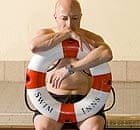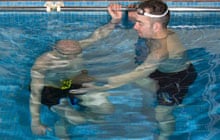At your local swimming pool you’ll see people of all ages splashing about, diving in and generally having fun. But look a little closer and you might see a man with a white-knuckle grip on the handrail. There’s a fixed smile on his face but fear in his eyes, and for all his splashing, he’s fooling no one. This man can’t swim.
Up until a few months ago, that man was me. I was a holder of the order of the armband, a fearful denizen of the shallows. Blame, and it is good to apportion blame for something you can’t do, had always been set squarely at: water’s inability to keep me afloat; Mrs Tench* and her tracksuit-clad ilk; whistles.
If I was ever going to stand a chance of swimming, I had to stop blaming nature, vitriolic instructors, and the shrill resonance of pea-powered signalling devices. But for the two decades that followed school, chlorine and I were rarely in the same room.
This all changed when my children came along. Soon I was back in the pool all too regularly for my liking. This grudging, rail-gripping dad would watch as wife and children splashed and swam. He’d field questions from his daughter about why he wasn’t joining in. This embarrassment, coupled with the paternal need to be able to swim to the rescue in the event of one of my offspring copping a lungful of water, eventually spurred me on to make a life-changing call.

Steve Cutt from Swim Inns was on the other end of the line. His residential learn-to-swim course had never failed to turn a ‘can’t swim’ into a ‘can swim’, he told me. Steve also assured me there’d be no tracksuits and definitely no whistles. Water, however, was unavoidable.
The five-day course certainly began differently to the last swimming lesson I had endured. Steve joined me and three other non-swimmers in the pool and talked at length about the body’s natural buoyancy. To prove this point we were encouraged to hold our breath and push ourselves under the water using the bar at the edge of the pool. By tucking my chin into my chest I was able to stop water going up my nose, while my flash-looking goggles let me see what I was doing and really helped to reduce the fear levels. I was amazed at how much effort it took to hold my body under the surface: perhaps water could keep me afloat after all.
From this confidence-building exercise we moved on to stretching out flat from the edge of the pool with our faces in the water to further aid our belief in buoyancy.

But it all started going wrong with the next exercise: gliding. Gliding involves crossing the width of the pool with just a kick off the wall. Three times I failed to move from the side on Steve’s command, but on the fourth attempt I gave a big kick and propelled myself across the pool.
By the next morning the whole group was capable of floating, some better than others. Men, apparently, don’t float as well as women, and I was the worst floater in the group. If ever there was an inglorious title to hold, that was it. Still, my leaden body helped enormously when Steve asked us to dive down and touch the floor of the pool with our noses. By propelling ourselves to the bottom of the pool with freshly learned breaststroke arms, we all ended up doing the best part of a width underwater.
After another day of sub-aquatic activity, I then struggled with swimming on the surface – mainly because I could see the vast, terrifying watery expanse in front of me. I got over this, and continue to do so, by starting off underwater before popping up to the surface after a couple of strokes.

By the end of the course I’d swum a length of the pool, jumped in, sunk down and bobbed up again in the deep end, and generally overcome the base fear that gripped me every time I went near water. Since then I’ve been practising regularly at my local pool. I’m slow, and my legs aren’t very well synched, but I’m getting better with each visit. I get the occasional quizzical look from other swimmers, but I don’t care – my days of bar-gripping and blaming are behind me.
* This is a suitably water-based pseudonym to protect the identity of the instructor in question, but close enough to her real name so she’ll know that she’s being talked about.
What to take on a swimming course
Goggles Screwing your eyes up to stop water getting in only increases tension. Goggles let you keep your eyes wide open and aid relaxation in the water.
A word on swimming attire for men learning to swim Skin-tight trunks suggest a competence in matters aquatic that you don’t yet possess. They also look ridiculous unless you have a Baywatch-spec body. Stick to swimming shorts instead.
Nose peg (optional) Good: Stops you inhaling water. Bad: Makes you sound like a Network Rail announcer.
Other good swimming schools
Swimming Without Stress
swimmingwithoutstress.co.uk
Learn To Swim With Us
swimwithus.co.uk
Source: Read Full Article
